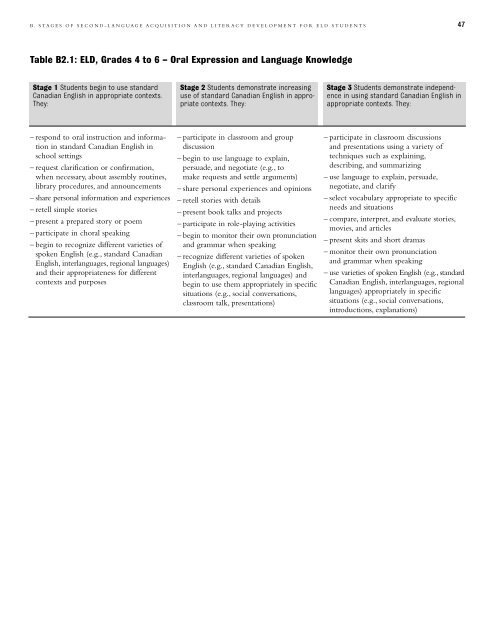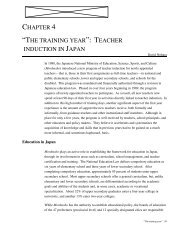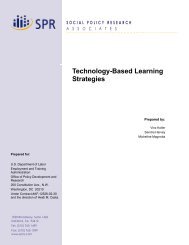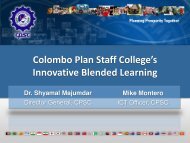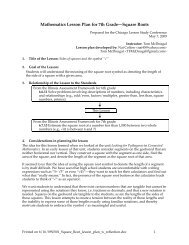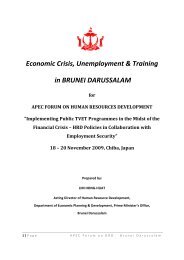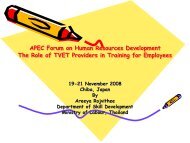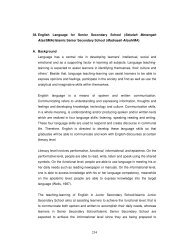46 THE ONTARIO CURRICULUM, GRADES 1– 8: ESL AND ELD – A RESOURCE GUIDETable B1.4: ELD, Grades 1 to 3 – OrientationStage 1 Students begin to adaptto new environments, bothpersonal <strong>and</strong> academic. They:Stage 2 Students demonstrateunderst<strong>and</strong>ing of <strong>and</strong> adaptationto new environments, bothpersonal <strong>and</strong> academic. They:Stage 3 Students demonstrateincreasing underst<strong>and</strong>ing of <strong>and</strong>involvement in new environments,both personal <strong>and</strong> academic.They:Stage 4 Students demonstrateawareness of self <strong>and</strong> othersas part of the Canadian context.They:– take pride in <strong>and</strong> respect theirown culture– locate key school locations(e.g., washrooms)– begin to underst<strong>and</strong> <strong>and</strong>follow essential schoolnorms, schedules, routines,<strong>and</strong> emergency procedures– ask for assistance <strong>and</strong> communicateneeds to appropriateschool personnel <strong>and</strong>/or peers– begin to relate informationabout Canada (e.g., climate,holidays, safety) to theirown activities <strong>and</strong> interests– work with a partner on acommon academic task– begin to adapt to a varietyof teaching approaches <strong>and</strong>strategies used in a Canadianclassroom– respect other cultures– participate with increasingcomfort <strong>and</strong> confidencein classroom activities– demonstrate underst<strong>and</strong>ing ofbasic information about thecommunity <strong>and</strong> about Canada– participate in directed groupwork such as simple researchprojects– respond with increasingconfidence to a variety ofteaching approaches <strong>and</strong>strategies (e.g., an informalclassroom atmosphere, activelearning, the use of gamesas a learning activity, activitiesthat involve asking questionsof a teacher)– show interest in other cultures– explain school norms, routines,behaviour expectations, <strong>and</strong>emergency procedures tonew students– discuss some current events– show increasing initiative incooperative group activitiessuch as research projects– respond appropriately to mostteaching approaches <strong>and</strong>strategies (e.g., an informalclassroom atmosphere, activelearning, use of games as alearning activity, activitiesthat involve asking questionsof a teacher)– identify <strong>and</strong> appreciate thecontributions of variouscultures within Canada– contribute fully in a small,cooperative group to create afinal product or presentation– learn effectively from a varietyof teaching approaches <strong>and</strong>strategies (e.g., an informalclassroom atmosphere, activelearning, the use of games asa learning activity, activitiesthat involve asking questionsof a teacher)
B. STAGES OF SECOND-LANGUAGE ACQUISITION AND LITERACY DEVELOPMENT FOR ELD STUDENTS47Table B2.1: ELD, Grades 4 to 6 – Oral Expression <strong>and</strong> <strong>Language</strong> KnowledgeStage 1 Students begin to use st<strong>and</strong>ardCanadian <strong>English</strong> in appropriate contexts.They:Stage 2 Students demonstrate increasinguse of st<strong>and</strong>ard Canadian <strong>English</strong> in appropriatecontexts. They:Stage 3 Students demonstrate independencein using st<strong>and</strong>ard Canadian <strong>English</strong> inappropriate contexts. They:– respond to oral instruction <strong>and</strong> informationin st<strong>and</strong>ard Canadian <strong>English</strong> inschool settings– request clarification or confirmation,when necessary, about assembly routines,library procedures, <strong>and</strong> announcements– share personal information <strong>and</strong> experiences– retell simple stories– present a prepared story or poem– participate in choral speaking– begin to recognize different varieties ofspoken <strong>English</strong> (e.g., st<strong>and</strong>ard Canadian<strong>English</strong>, interlanguages, regional languages)<strong>and</strong> their appropriateness for differentcontexts <strong>and</strong> purposes– participate in classroom <strong>and</strong> groupdiscussion– begin to use language to explain,persuade, <strong>and</strong> negotiate (e.g., tomake requests <strong>and</strong> settle arguments)– share personal experiences <strong>and</strong> opinions– retell stories with details– present book talks <strong>and</strong> projects– participate in role-playing activities– begin to monitor their own pronunciation<strong>and</strong> grammar when speaking– recognize different varieties of spoken<strong>English</strong> (e.g., st<strong>and</strong>ard Canadian <strong>English</strong>,interlanguages, regional languages) <strong>and</strong>begin to use them appropriately in specificsituations (e.g., social conversations,classroom talk, presentations)– participate in classroom discussions<strong>and</strong> presentations using a variety oftechniques such as explaining,describing, <strong>and</strong> summarizing– use language to explain, persuade,negotiate, <strong>and</strong> clarify– select vocabulary appropriate to specificneeds <strong>and</strong> situations– compare, interpret, <strong>and</strong> evaluate stories,movies, <strong>and</strong> articles– present skits <strong>and</strong> short dramas– monitor their own pronunciation<strong>and</strong> grammar when speaking– use varieties of spoken <strong>English</strong> (e.g., st<strong>and</strong>ardCanadian <strong>English</strong>, interlanguages, regionallanguages) appropriately in specificsituations (e.g., social conversations,introductions, explanations)
- Page 3 and 4: ContentsPreface . . . . . . . . . .
- Page 7 and 8: PART 1ESL/ELD Program Consideration
- Page 9 and 10: INTRODUCTION7are in common use. Unl
- Page 11 and 12: 9Stages of Second-Language Acquisit
- Page 13 and 14: STAGES OF SECOND-LANGUAGE ACQUISITI
- Page 15 and 16: 13The Role of the School: Establish
- Page 17 and 18: THE ROLE OF THE SCHOOL15are not rel
- Page 19 and 20: THE ROLE OF THE CLASSROOM TEACHER A
- Page 21 and 22: THE ROLE OF THE CLASSROOM TEACHER A
- Page 23 and 24: 21Assessment, Evaluation, and Repor
- Page 25: ASSESSMENT, EVALUATION, AND REPORTI
- Page 30 and 31: 28A. Stages of Second-Language Acqu
- Page 32 and 33: 30 THE ONTARIO CURRICULUM, GRADES 1
- Page 34: 32 THE ONTARIO CURRICULUM, GRADES 1
- Page 37 and 38: A. STAGES OF SECOND-LANGUAGE ACQUIS
- Page 39 and 40: A. STAGES OF SECOND-LANGUAGE ACQUIS
- Page 41 and 42: A. STAGES OF SECOND-LANGUAGE ACQUIS
- Page 43 and 44: A. STAGES OF SECOND-LANGUAGE ACQUIS
- Page 45 and 46: 43B. Stages of Second-Language Acqu
- Page 47: B. STAGES OF SECOND-LANGUAGE ACQUIS
- Page 51 and 52: B. STAGES OF SECOND-LANGUAGE ACQUIS
- Page 53 and 54: B. STAGES OF SECOND-LANGUAGE ACQUIS
- Page 55 and 56: B. STAGES OF SECOND-LANGUAGE ACQUIS
- Page 57 and 58: PART 3Sample Adaptations and Modifi
- Page 59 and 60: INTRODUCTION57Culminating Task. The
- Page 61 and 62: GRADE 1, SOCIAL STUDIES59Expectatio
- Page 63 and 64: GRADE 1, SOCIAL STUDIES61• Use vi
- Page 65 and 66: GRADE 1, SOCIAL STUDIES63Communicat
- Page 67 and 68: GRADE 2, SCIENCE AND TECHNOLOGY65Ex
- Page 69 and 70: GRADE 2, SCIENCE AND TECHNOLOGY67As
- Page 71 and 72: GRADE 2, SCIENCE AND TECHNOLOGY69Te
- Page 73 and 74: 71Grade 3, LanguageGenre StudyThis
- Page 75 and 76: GRADE 3, LANGUAGE73Assessment Rubri
- Page 77 and 78: GRADE 3, LANGUAGE75Teaching the Use
- Page 79 and 80: GRADE 3, LANGUAGE77Using Centres•
- Page 81 and 82: GRADE 4, MATHEMATICS79Expectations
- Page 83 and 84: GRADE 4, MATHEMATICS81Assessment Ru
- Page 85 and 86: GRADE 4, MATHEMATICS83Strategies•
- Page 87 and 88: 85Grade 5, Science and TechnologyEa
- Page 89 and 90: GRADE 5, SCIENCE AND TECHNOLOGY87Cu
- Page 91 and 92: GRADE 5, SCIENCE AND TECHNOLOGY89As
- Page 93 and 94: GRADE 5, SCIENCE AND TECHNOLOGY91
- Page 95 and 96: GRADE 6, SOCIAL STUDIES93Expectatio
- Page 97 and 98: GRADE 6, SOCIAL STUDIES95Assessment
- Page 99 and 100:
GRADE 6, SOCIAL STUDIES97• Use th
- Page 101 and 102:
GRADE 7, HISTORY99Expectations and
- Page 103 and 104:
GRADE 7, HISTORY101Assessment Rubri
- Page 105 and 106:
GRADE 7, HISTORY103• Have student
- Page 107 and 108:
GRADE 7, GEOGRAPHY105Expectations a
- Page 109 and 110:
GRADE 7, GEOGRAPHY107Assessment Rub
- Page 111 and 112:
GRADE 7, GEOGRAPHY109Summative Stra
- Page 113 and 114:
GRADE 8, SCIENCE AND TECHNOLOGY111E
- Page 115 and 116:
GRADE 8, SCIENCE AND TECHNOLOGY113A
- Page 117 and 118:
GRADE 8, SCIENCE AND TECHNOLOGY115T
- Page 119 and 120:
GRADE 8, LANGUAGE117Expectations an
- Page 121 and 122:
GRADE 8, LANGUAGE119Assessment Rubr
- Page 123 and 124:
121Glossaryassessment. The ongoing
- Page 125 and 126:
The Ministry of Education wishes to


